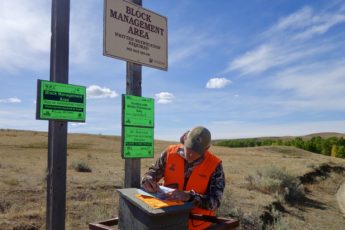LOCAL EFFORTS TO MANAGE SALT CEDAR ON THE MISSOURI RIVER OF MONTANA PAY OFF
Written by Rachel Frost
People may be more spread out on the eastern half of the state, but they’re coming closer together. Group after group are working on community-level solutions to some of rural Montana’s most complicated problems. Check back this winter to find inspiration for your own community.
The Missouri River Breaks are known for their rugged beauty, and the remarkable wildlife populations that call that region home. What residents of the Missouri River Breaks do not want them to be known for is a home to invasive plants, such as salt cedar (Tamarisk ramosissima). Salt cedar is an invasive tree that spreads rapidly along river banks and lake shores, replacing the iconic cottonwood and using large volumes of water during the warm summer months. Noxious weeds like salt cedar trees have a destructive impact on Montana’s landscape by displacing native plant species, increasing soil erosion, and decreasing wildlife habitat and recreational opportunities, according to the Montana Department of Agriculture.
But salt cedar is not as recognizable as leafy spurge or spotted knap weed as an invasive species. Therefore,land managers failed to prioritize it, causing salt cedar to become a real problem on the Missouri River banks and its tributaries, as well as on the shores of Fort Peck Lake. Some landowners fought salt cedar on their own, but few seemed to stem the spread of the invasive tree. There was no collective strategy to stop the expansion of salt cedar.
The reason for the lack of management success lies in Montana’s land ownership patterns as much as in salt cedar’s tenacious ability to produce millions of seeds. The seeds are carried by water and flow across several federal, state and private lands whose owners have differing budgets and priorities differ on weed management. Not surprisingly, their efforts resulted in spotty control, with no real hope of removing salt cedar from the landscape.
That was the scenario until the local conservation districts got involved. Members of the conservation districts recognized the problem and wanted to see a more organized approach to salt cedar management. They called on their regional conservation district group, the Missouri River Conservation Districts Council, to gather stakeholders and discuss salt cedar management. The collaboration, the first meeting of the Montana Salt Cedar Team, boasted over 40 attendees, including four federal agencies, two state agencies, the Montana State University Extension Service, county weed coordinators, conservation district representatives and local landowners.
But making the gathering unique was Patricia Gilbert, Natural Resource Manager for the US Army Corps of Engineers stationed at the Fort Peck Project, who devised a map and plan. The treatment area that she proposed was rugged, remote and complicated. Stretching seven miles into the Seven Blackfoot drainage in Garfield County across federal, state and private land, Gilbert’s map proposed a bold project that would test the commitment of the group. She knew if the project was a success, then any future project would seem like a piece of cake. Despite funding cuts that threatened to end the project, several factors played into the project completion in the fall of 2017: several stakeholder conversations, letters of support for the project to agency leaders, and the personal relationships among local conservation district supervisors and their constituents. More than a win against salt cedar, the project created goodwill throughout Garfield County and helped improve relationships with private landowners and their federal land management neighbors.
“It’s important that we all understand how management of weeds on our land affects our neighbors and their land,” Gilbert said about the vital collaborations and awareness-raising.
The second project involved a coordinated treatment of 114 miles along the Missouri River. Gilbert was again project leader. She proposed an equally bold move to eradicate salt cedar on the 100-plus miles from Wolf Point to the North Dakota border. This time the team sought funding and support from Montana’s Department of Natural Resources and Conservation and a Montana Conservation Corps crew to treat the salt cedar.
William Friedman,
Did you find this inspiring? Group after group are working on community-level solutions to some of rural Montana’s most complicated problems. Check out the rest of the series to find inspiration for your own community.
Rachel Frost is the Coordinator for the Missouri River Conservation Districts Council which serves 15 Conservation Districts on the 790 miles of the Missouri River in Montana. She and her husband, Jason, live near Livingston where they are raising two teenage daughters to be future leaders of agriculture and appreciate a rural lifestyle.
Got something to say to Prairie Populist? Send news tips, story ideas and comments to [email protected]. If you have something to submit, or an idea for a story you’d like to write for us, check out our Submission Guidelines here.


